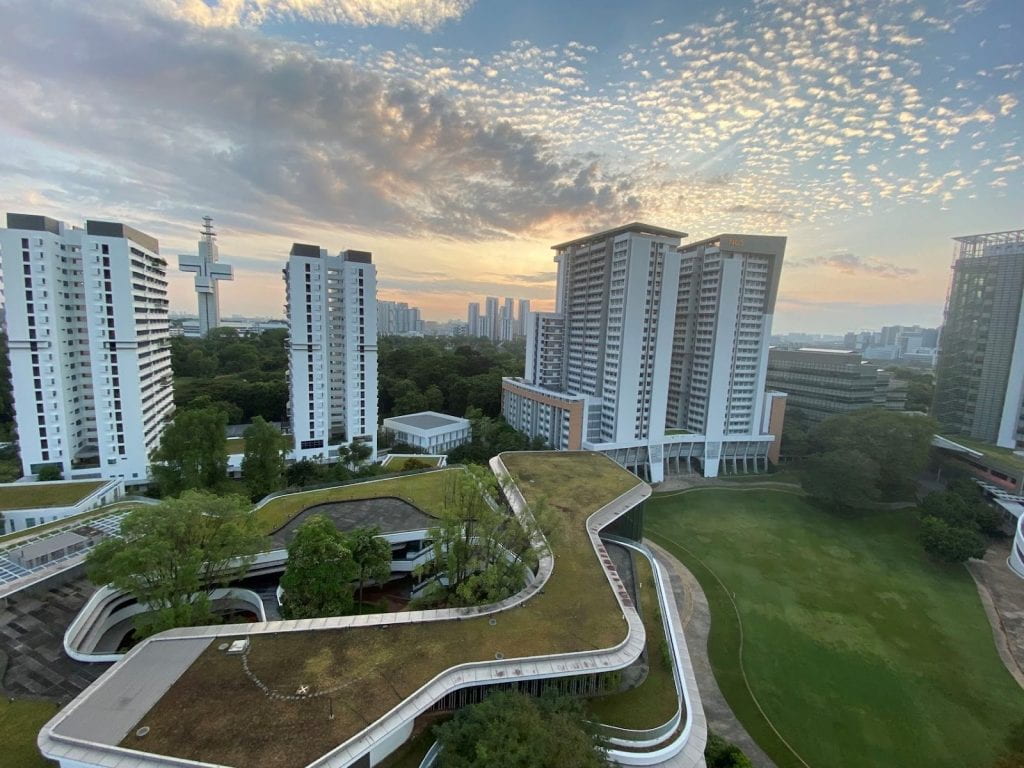Beyond the Familiar: First Impressions of Singapore
Five years ago, I was fifteen and traveled to Singapore for the first time. Although few memories remain from that short trip, I distinctly remember being captivated by the lush greenery enveloping the bustling cityscape, and awed by the sustainability of the densely-populated city lacking in natural resources. I’ve been in Singapore for almost a month now, retracing and rediscovering the impressions from my first visit. Recollections from my last visit lend a sense of familiarity to the city, yet it still never fails to fill me with wonder. Every morning, I am mesmerized by the greenery surrounding the buildings, an almost surreal view from my dorm room window.


Views from my dorm room, with NUS residential colleges, academic buildings, and UTown town green
For me, Singapore is the perfect setting to explore the intersection between sustainability and urban development. As an exchange student at Yale-NUS, I’ll be exploring sustainability and urban development in an academic setting to complement my lived experiences in the city. Unlike most liberal arts colleges, Yale-NUS offers a dedicated Urban Studies major; currently, I am taking Cities A to Z, an introductory course in Urban Studies exploring the nature of cities and the processes of urbanization of different cities. The class is unique for its breadth and comparative focus – each module serves as a case study of a city around the world. To acquire historical background on the region and its unique identities, I am also taking an introductory Southeast Asia Studies module at NUS. A topic that has fascinated me most is Southeast Asia’s use of its colonial and pre-colonial legacies; in particular, Singapore’s adaptive reuse of its national heritage sites such as Chinatown, Kampong Glam, and Little India. Despite physically preserving the buildings, gentrification can contribute to historical amnesia and the displacement of communities that gave life to the location. It’s led me to reconsider many of the destinations here that have attracted me as a visitor in Singapore, as well as the relationship between cultural preservation and modernization in general. While engaging with these social science courses as a STEM major has definitely required some adjustments in the learning process, I’ve enjoyed the challenges of this new mode of thinking. Moving forward, I’m excited to acquire a deeper understanding of the challenges and characteristics of the Garden City’s urban development and explore the relation between Singapore’s urban environment with its social, economic, and political values.

I chose to study in Singapore not only to gain a better understanding of our urban surroundings, but also for the opportunity to reflect upon my own identity. In truth, I had many expectations before arriving in Singapore: I would often imagine what the transition process would be like, the cultural differences I would encounter, and whether I would find belonging to the new milieu. I was initially drawn to Singapore for its cultural diversity and its unique fusion of Eastern and Western traditions, and as an Asian-American, I envisioned a relatively smooth and seamless transition into Yale-NUS and Singapore. In some instances, those expectations held true. On campus, where 40% of the student body is international, my multicultural identity fostered a sense of belonging. My peers were curious about my upbringing, why I chose to study abroad, and the differences between the U.S. and Singapore. Outside of classes, I could freely transition between languages in conversation as most Singaporeans are fluent in English and Mandarin. However, I’m also continually introduced to new facets of Singapore and its culture, and I begin to realize the complexity of the nation that cannot be captured in conventional rigid categorizations such as CIMO (Chinese, Indian, Malay, Others). Perhaps this is what it means to see beyond our “bubbles” – those long-held beliefs and expectations shaped by our upbringing. I hope my blog will help document the process of understanding my bubble and expanding it, as well as the process of finding a sense of self and community in this familiar yet foreign country.

Finally, to share a bit of my life outside of classes so far. Last week was the lunar new year, and a Singaporean friend invited me to her house to celebrate. This was my first time celebrating the new year away from family, and it felt refreshing to be “home” after a month of dorm life. That night, I had the opportunity to observe and participate in traditional Singaporean new year festivities such Lohei (捞起), where family and friends come together to toss Yusheng (鱼生), a raw fish salad consisting of thinly shredded vegetables, seasonings, raw fish, and condiments. The word Yusheng is a beautiful play on the homophone for “fish” and “abundance”, and an auspicious phrase is recited with each ingredient added. The Lohei was loud and chaotic, yet colorful and joyous. Overall, it was eye-opening to experience a familiar, traditional celebration in a forgein setting. Happy new year, and I’ll see you in my next post!